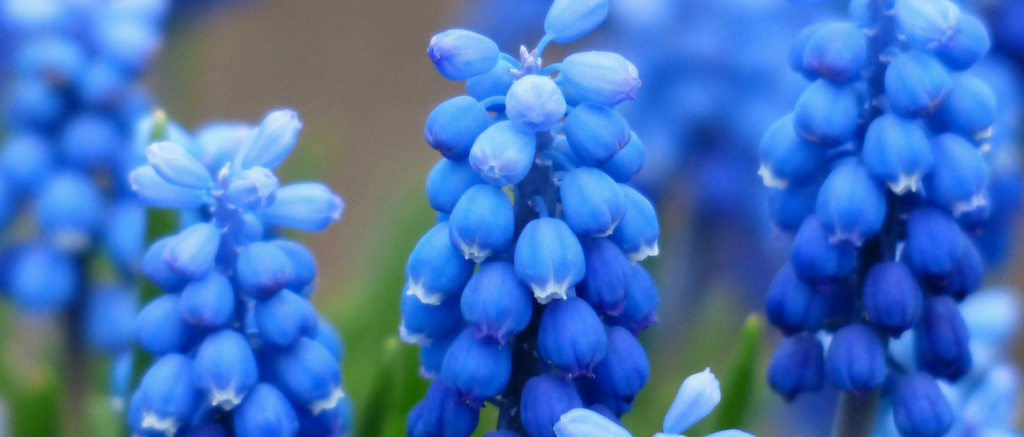
Muscari: Planting, Growing Advice and Care
Contents
Muscari in a nutshell
- In spring, its deep blue or white flowers are essential in the garden
- It tolerates both full sun and partial shade
- Low-maintenance and very hardy, the Muscari offers excellent cold resistance (-25°C)
- It naturalises very quickly
- It can be grown in pots as well as in large flowering carpets
Our expert's word
The Muscari, also known as grape hyacinth, is a charming little spring bulb, easy to grow, fully hardy and thriving anywhere with no maintenance required. A herald of spring, its clusters of intense blue or white flowers bloom from March to May and are essential in every garden. From the classic Muscari armeniacum or Armenian grape hyacinth to the Muscari aucheri White Magic, M. botryoides, or even bicoloured varieties like Muscari neglectum or the unusual Tassel Hyacinth, Muscari comosum, this garden staple for low-maintenance spaces grows equally well in full sun or shade. Planted in well-drained soil, it naturalises easily, forming over the years lush flowering carpets and beautiful spring border displays.
You can never plant enough of these inexpensive little spring bulbs, which fit anywhere—whether in pots, borders, along pathways, as naturalised carpets, beneath trees in woodland settings, in rockeries, scattered across lawns, or even in Japanese-style or minimalist gardens. This prolific bulb has a knack for adding a fresh touch and enhancing all other spring bulbs it grows alongside, such as daffodils, jonquils, wood anemones, hyacinths, tulips…
Discover our collection of Muscari, ranging from sky blue to pure white and even pale pink, in small or extra-large sizes—perfect for creating stunning spring planters or brightening your garden in the very first year.
Botany
Botanical data
- Latin name Muscari
- Family Hyacinthaceae
- Common name grape hyacinth, muscari, cluster hyacinth
- Flowering March to May
- Height 0.15 to 0.60 cm
- Sun exposure Sun, Partial shade
- Soil type All types
- Hardiness down to -25°C
The Muscari, also known as grape hyacinth, is a plant from the Hyacinthaceae/Liliaceae family. This small bulbous perennial, native to the mountains of southeastern Europe, Armenia, Turkey and the Caucasus, grows naturally at woodland edges or on rocky slopes at high altitudes.
From its mountainous origins, Muscari has retained excellent hardiness. Capable of enduring severe frosts, it adapts well everywhere and can withstand temperatures as low as -25°C, depending on the species. Despite its delicate appearance, it’s a robust plant that, in addition to its cold resistance, tolerates drought and shade well.
The genus includes 30 species of bulbous perennials, including the classic Muscari armeniacum or Armenian grape hyacinth, Muscari aucheri (or Tubergenianum), botryoïdes, Muscari azureum with shorter foliage than other muscari species, some bicoloured varieties like Muscari latifolium, Muscari neglectum and Muscari macrocarpum, and the curious tassel hyacinth (Muscari comosum or ‘Plumosum’).
Muscari forms clumps that are more or less upright depending on the species, reaching up to 60 cm in height, with a spread of about 30 cm for the largest varieties. Within two to three seasons, the initially planted central bulb produces bulbils that spread steadily. Once well established in well-drained soil, it will flower for a good ten years, provided the bulbs are divided every 3-4 years to maintain the plant. Very prolific, if left undisturbed, Muscari naturalises easily at the base of deciduous hedges, in borders and lightly mown meadows. Muscari also self-seeds readily, forming fragrant flowering carpets over a few years.
From the first days of spring, Muscari displays its luminous, miniature hyacinth-like blooms. It forms waves of sky-blue or pure white flowers borne on fresh green grassy clumps. When the bulb is mature and well-developed after two years, each rosette produces 3 to 5 slender, upright flower spikes in spring, 10 to 60 cm tall. For several weeks from March to May, these leafless stems bear 20 to 40 small drooping flowers in terminal conical inflorescences that are non-toxic. The flower clusters are 10 to 30 cm tall and up to 5 cm wide for the largest varieties. Packed tightly like grapes, each bell-shaped flower’s tepals are just a few millimetres long, forming a small rattle with a often constricted mouth. The appearance of the inflorescences varies by species and variety. Muscari armeniacum ‘Blue Spike’, a spectacular variety, has very double flowers on a plump spike resembling a hyacinth. Muscari comosum ‘Plumosum’ features feathery lilac inflorescences composed of purple filaments, while the species type has spikes of small bell-shaped flowers topped with a feathery tuft of ultramarine to violet filaments. Muscari ‘Mountain Lady’ has unusual sky-blue flowers crowned with a small tuft of white blooms.
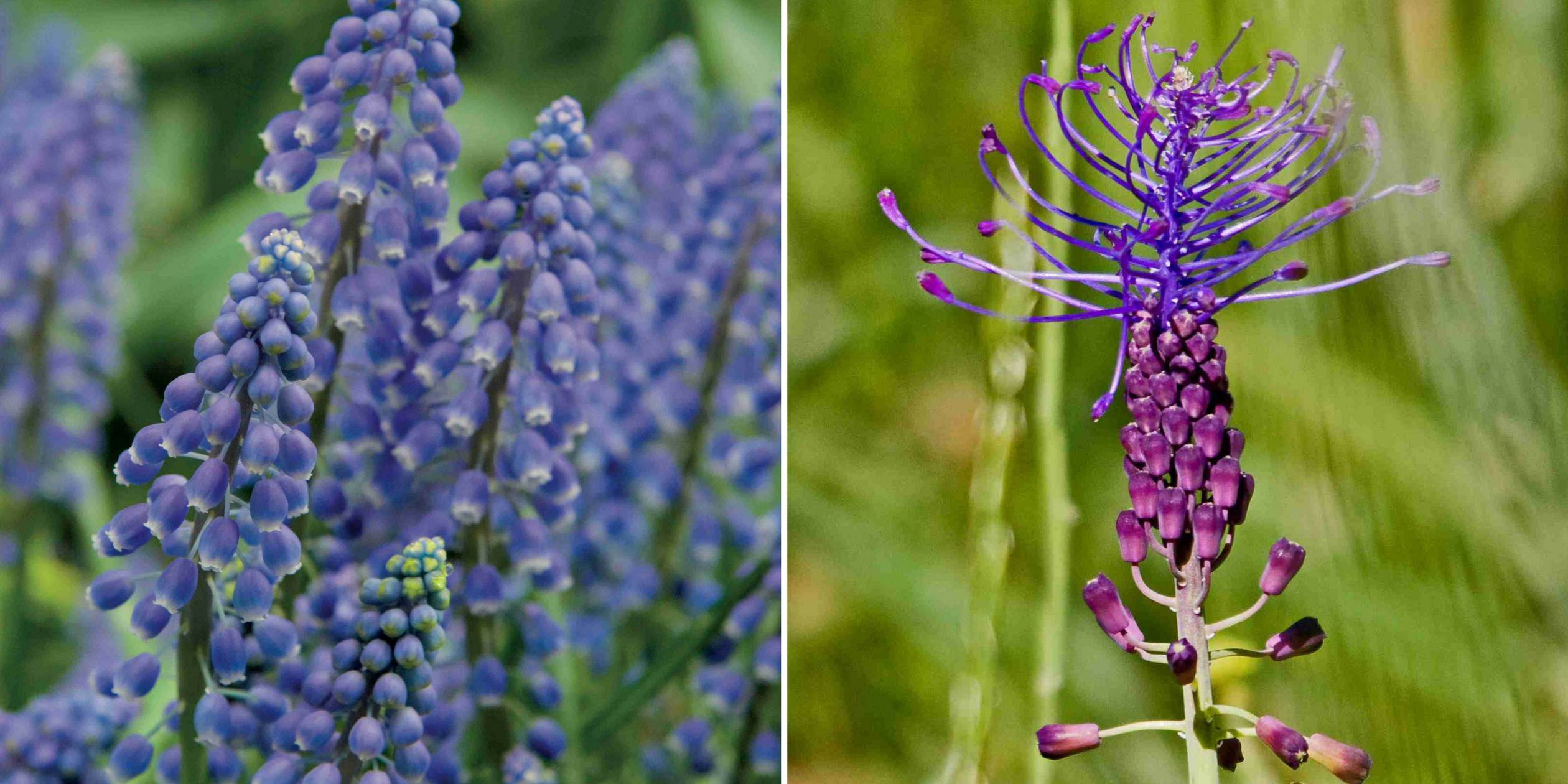
Muscari armeniacum and Muscari comosum ‘Plumosum’ with feathery inflorescences
These small flowers, mostly intense blue, bright blue, sky blue, cobalt or violet, can sometimes be white or soft pink, an unusual colour for muscari. The name Muscari comes from musk, the sometimes very intense, heady fragrance emitted by most Muscari flowers, with M. Aucheri ‘White Magic’ being one of the most fragrant. These intensely azure, powdery pink or pure white cones also make charming fresh little bouquets.
Muscari neglectum and Muscari azureum have bicoloured bells striped or edged with bluish white. Others have bicoloured clusters: those of Muscari macrocarpum change from purplish brown in bud to lemon yellow when mature, while Muscari latifolium has a crown of deeper-coloured flowers compared to those at the spike’s tip, which are sterile. Only the lower flowers produce seeds. Highly visited by pollinating insects, after pollination the faded flowers produce triangular fruits that release tiny black seeds which self-sow very easily.
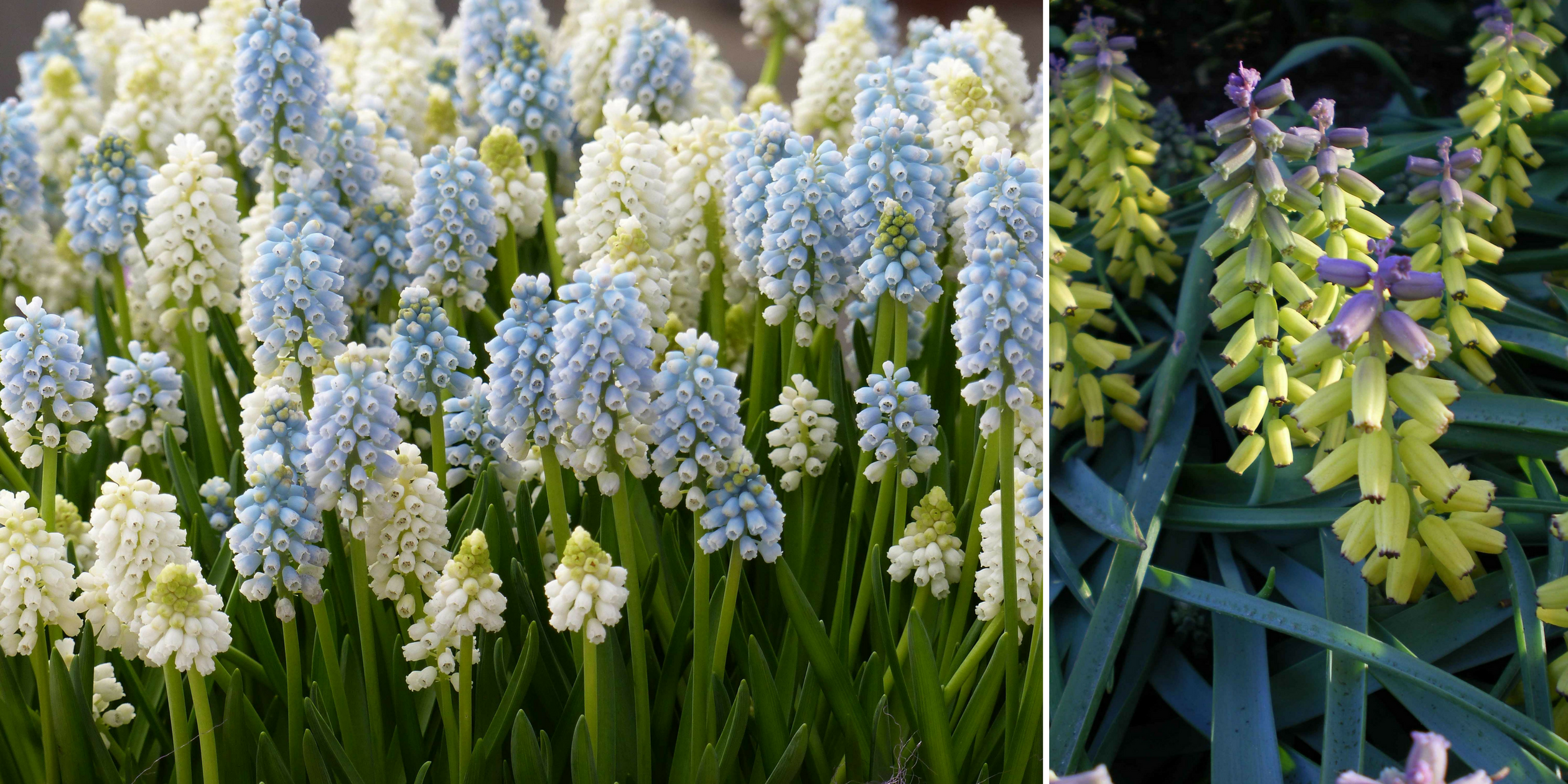
Some varieties like Muscari ‘Ocean Magic’ offer beautiful blue hues, while Muscari macrocarpum provides striking contrasts
With Muscari, foliage generally appears before the inflorescence: its growing cycle begins in late summer, with some leaves appearing and persisting through winter. In early spring, more leaves emerge from a green basal rosette, then the foliage develops with flowering. 6 to 30 cm long, fleshy, narrow, linear, often folded lengthwise or spoon-shaped, they resemble snowdrop leaves or, like Muscari neglectum‘s finer, more slender foliage, recall grass blades. Light green to greyish green, sometimes shorter than the stem, they form a nest of greenery against which the often intensely coloured flower spikes stand out. In summer, the leaves yellow and the plant goes dormant. Deciduous, the foliage disappears after flowering and returns in autumn.
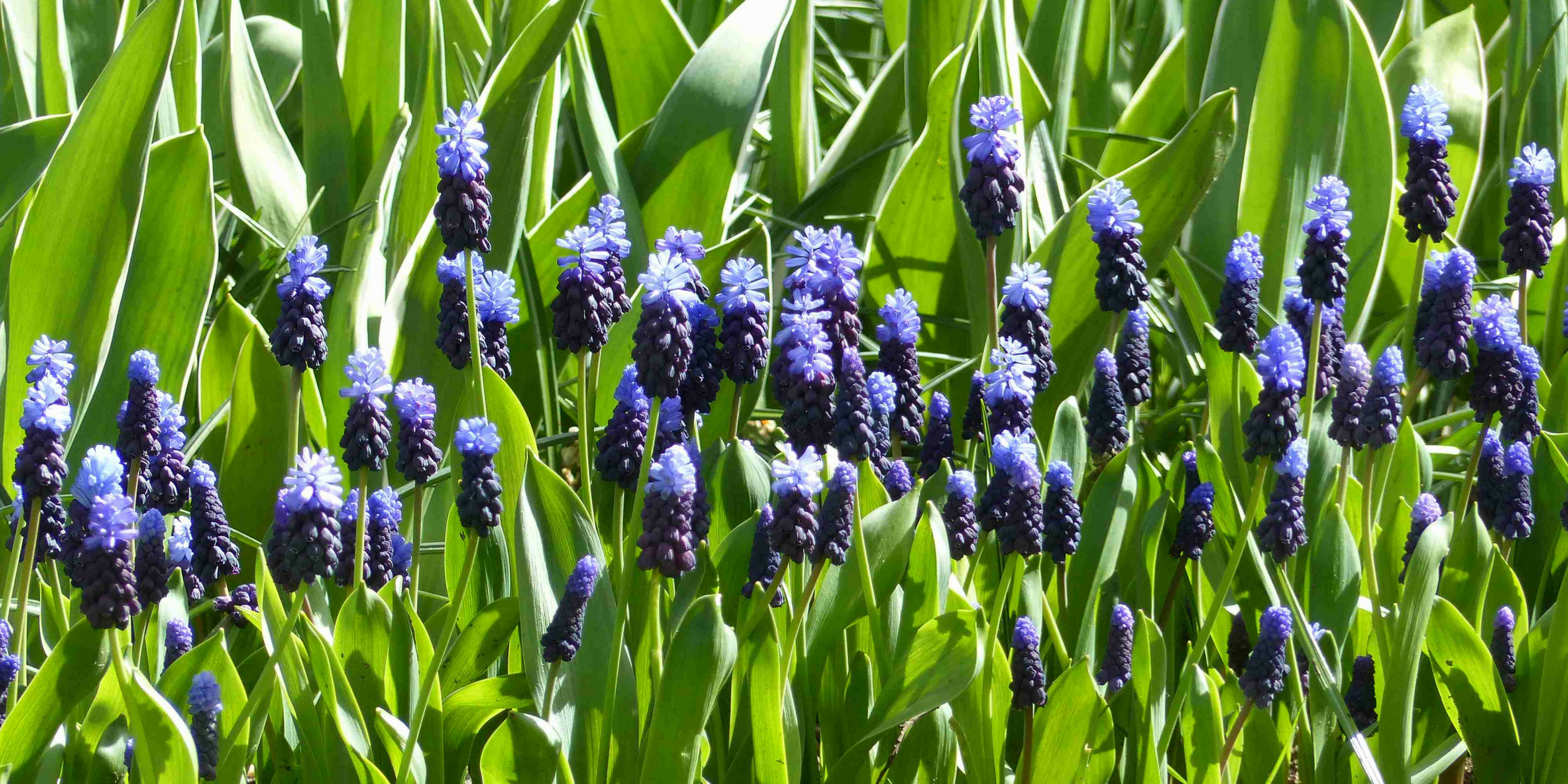
Only Muscari latifolium has a single broad, fleshy, glaucous green leaf that curls at the base
Very easy to grow and accommodating, Muscari thrives everywhere and multiplies quickly in all fairly fertile, moist, well-drained soils. While it prefers sunny spots, it will also flower in partial shade. It can even be planted in woodland as it flowers before deciduous trees leaf out.
Discreet and versatile, Muscari suits many situations, creating delicate scenes or thriving in semi-wild garden corners. It flowers in all garden areas, including balconies. For a decorative, spectacular effect, plant Muscari en masse, in groups of about ten bulbs, as flowering carpets under trees, along paths, in rockeries or gravel gardens, scattered in lightly mown meadows or in Japanese-style gardens.
Small Muscari bulbs can be tucked anywhere among existing plants without disturbing perennials and shrubs, as they disappear underground when these start growing. This bulb thrives alongside many other spring bulbs – daffodils, narcissus, anemones, hyacinths – which its luminous blooms highlight beautifully. Early pink or white tulips also make good companions for its graceful flowering. Muscaris can also be combined to create oceans of blue flowers. All Muscaris are suitable for container cultivation mixed with pansies, narcissus, crocus, hyacinths or primroses.
Species and varieties
There are essentially about ten species cultivated in our gardens, including Muscari armeniacum or Armenian grape hyacinth, which is the most common. You can also find white muscaris like aucheri (or Tubergenianum) and Muscari botryoides, Muscari azureum with shorter foliage than other species, as well as some bicoloured varieties such as Muscari latifolium, Muscari neglectum, and Muscari macrocarpum. And the peculiar tassel hyacinth, Muscari comosum (or ‘Plumosum’).
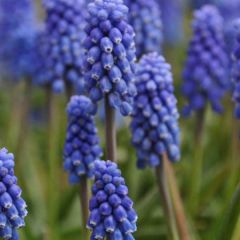
Muscari armeniacum Dark Eyes - Grape Hyacinth
- Flowering time April, May
- Height at maturity 20 cm
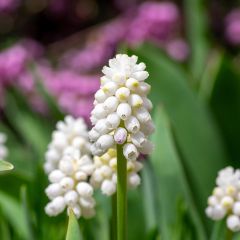
Muscari aucheri White Magic - Grape Hyacinth
- Flowering time May, June
- Height at maturity 20 cm
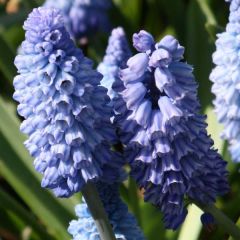
Muscari azureum - Grape Hyacinth
- Flowering time May, June
- Height at maturity 15 cm
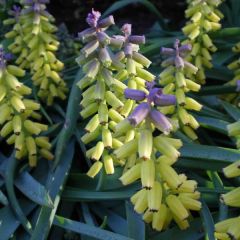
Muscari macrocarpum Golden Fragrance
- Flowering time May
- Height at maturity 15 cm
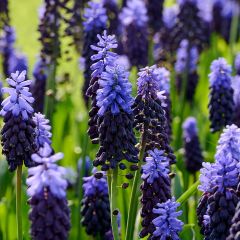
Muscari latifolium - Grape Hyacinth
- Flowering time May, June
- Height at maturity 30 cm
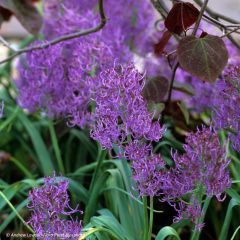
Muscari comosum Plumosum - Grape Hyacinth
- Flowering time May, June
- Height at maturity 15 cm
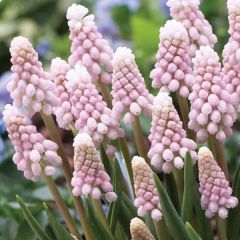
Muscari Pink Sunrise - Grape Hyacinth
- Flowering time May, June
- Height at maturity 15 cm
Discover other Muscari
Planting
When to Plant Muscari?
These small bulbs should be planted early in the season, from September until mid-November, both in the ground and in pots.
Where to Plant These Flower Bulbs?
Muscari are not fussy about soil type or exposure and are fully hardy in all regions. They quickly form flowering carpets without ever becoming invasive. They can be tucked in anywhere, between existing plants, and will fill gaps in two or three years if allowed to spread naturally.
Plant them in full sun or partial shade, in ordinary, fairly fertile soil that is moist but well-drained—they dislike waterlogged conditions. Muscari armeniacum tolerates even dry summer soils, while others like Muscari botryoides thrive in clay soils. The Muscari macrocarpum needs summer heat to flower well. Moderately hardy (-7°C), in harsh winter regions, mulch the soil or store the bulbs, while other species can remain in the ground.
Some, like M. armeniacum, have wilted foliage by flowering time, forming a slightly untidy carpet that can be easily concealed by planting among Erythronium, wood anemones, Pulmonaria, or Euphorbia.
Versatile, Muscari suit all settings—woodland areas, under trees, along pathways, in rockeries, or scattered in meadows or lawns. All Muscari varieties make beautiful potted displays.
How to Plant Muscari?
Plant generously—Muscari are best planted en masse (they’re economical) and close together for maximum impact, in well-drained soil to prevent bulb rot.
- Loosen the soil deeply
- Improve drainage if needed by mixing gravel into the soil or placing a layer beneath the bulbs
- Plant 10 cm deep, with the bulb tip facing upwards
- Space bulbs 8 cm apart or plant in clusters of about ten, ensuring they don’t touch
- Cover with twice the bulb’s height in soil
- Water moderately
- After 2 years, divide clumps and replant the bulblets (this extends coverage and enhances flower vigour)
Container Cultivation
Like hyacinths, Muscari bulbs can easily be forced in cold conditions from autumn to enjoy their blooms and fragrance indoors. For outdoor use on patios or balconies, choose a sunny spot and larger bulbs for bigger flowers. You can also plant them in pots in the first year before transferring them to the ground.
- Place a layer of clay pebbles at the bottom of a terracotta pot for perfect drainage
- Fill with a mix of garden soil, compost, and pumice
- Plant densely (about ten bulbs per pot) and cover with twice the bulb’s height in soil
- Water regularly in autumn and winter, then reduce in summer, stopping completely during dormancy
Care and Maintenance
Muscari is such an easy-going plant that it requires no watering except when grown in pots, nor any particular care. When the foliage turns yellow in summer, after 3-4 years, it’s time to lift the bulbs and separate the bulbils to maintain good vigour. No pruning is necessary, though if you wish to control propagation by limiting self-seeding, cut the flower stalks after blooming. However, only remove the foliage once it has withered, to allow the bulb time to replenish its reserves during the summer dormancy period. Muscari bulbs are frost-hardy and can remain in the ground year after year, quickly forming prolific flowering carpets. In regions with harsh winters, prefer container planting for less hardy species like Muscari macrocarpum or dig up and overwinter the bulbs in a frost-free place. In autumn, you may add some well-rotted compost by lightly forking it in around the base of the plants; this will help the bulbs flower well the following spring.
In containers:
- Water regularly
- Apply bulb fertiliser until the end of flowering
Possible diseases
When planted in suitable conditions, Muscari shows excellent disease resistance. However, watch out for aphid attacks, which can sometimes cause viruses that discolour the foliage and flowers. In this case, simply dig up and remove affected bulbs.
Propagation
Sowing
Germination of Grape Hyacinths seeds is slow and unpredictable, especially since a plant grown from seed will take several years to flower and Grape Hyacinths readily self-seed naturally. We recommend division instead, which is very simple to do.
Division
After two years of growth, you can divide the clumps and separate the bulbils. Do this in June and until early autumn when the leaves turn yellow.
- Dig up the clump with a garden fork
- Separate the bulbs by hand or with a small knife
- Replant the Grape Hyacinths immediately
- Water lightly
→ Also discover how to propagate bulbs by scaling in our tutorial!
Pairing
Versatile, Muscari is exceptionally easy to pair and combines beautifully with a multitude of low-maintenance plants. Cheerful yet understated, it thrives in naturalistic gardens without constant care or weekend gardens. Planted en masse, this small bulb creates maximum impact, forming carpets of blue, white, or even pink flowers in spring gardens, and stunning foreground displays in flower beds.
With its luminous blooms, Muscari adapts to numerous settings as flowering carpets, at woodland edges beneath trees, scattered across lawns, to adorn path borders or sunny rockeries, or even in Japanese-style gardens. This radiant bulb thrives alongside other spring bulbs, Anemone sylvestris, Hyacinths, Ipheions, Iris reticulata, Erythroniums. Lungworts and Euphorbias make superb companions for these petite spring bulbs.
Muscari creates magnificent carpets against backdrops of Daffodils, Jonquils and early Tulips, in striking blue/yellow-green contrasts or in fresh white/blue scenes brimming with delicacy. Combined together, they produce fantastic blue tides at the heart of spring. All lend themselves beautifully to container cultivation on windowsills or balconies, mixed with Pansies, miniature Daffodils, Crocuses, Forget-me-nots or primroses.
Looking for more inspiration? Discover our advice sheet: “Muscari: 8 Beautiful Pairing Ideas”
Useful resources
- Check out our advice sheet on growing Muscari in pots
- Our Depth Guide for Spring Bulbs
- Advice sheet: Which bulbs to grow indoors?
- Advice sheet: Bulb sizing: understanding to choose better
- Advice sheet: 6 bulbs to naturalise in your garden
- Discover our video about Muscari armeniacum
- Our advice sheet: 9 blue-flowering bulbs you must have in your garden
Frequently asked questions
-
Why is my muscari turning yellow?
In summer, the Muscari enters dormancy, known as "summer dormancy". This is a necessary period for the plant, allowing it to build up reserves for the following spring. Even if you find the yellowing leaves create a somewhat unsightly carpet, only cut back the foliage once it has completely withered, giving the bulb time to replenish its reserves.
- Subscribe!
- Contents


































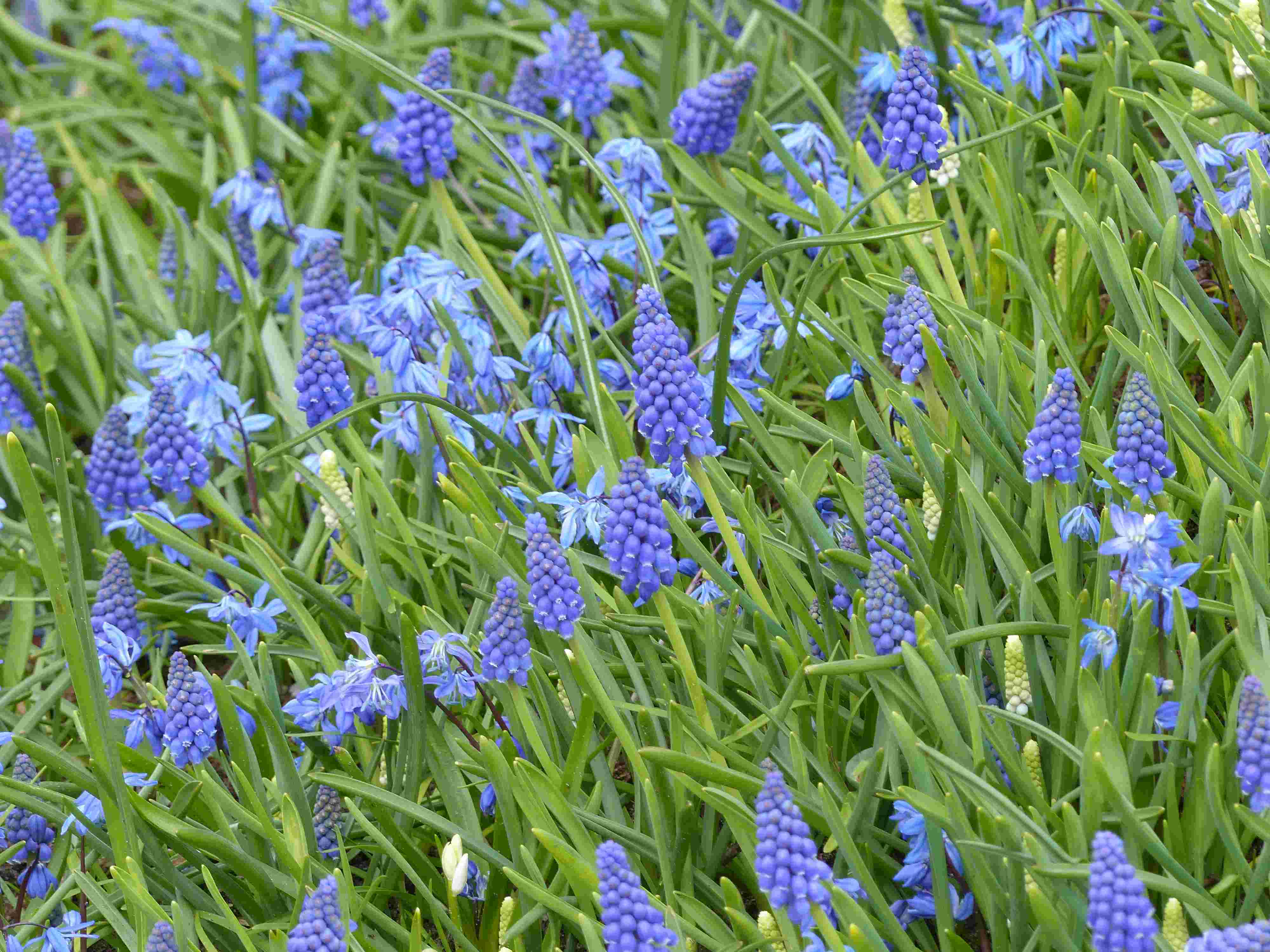
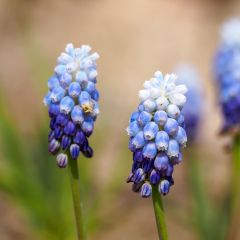
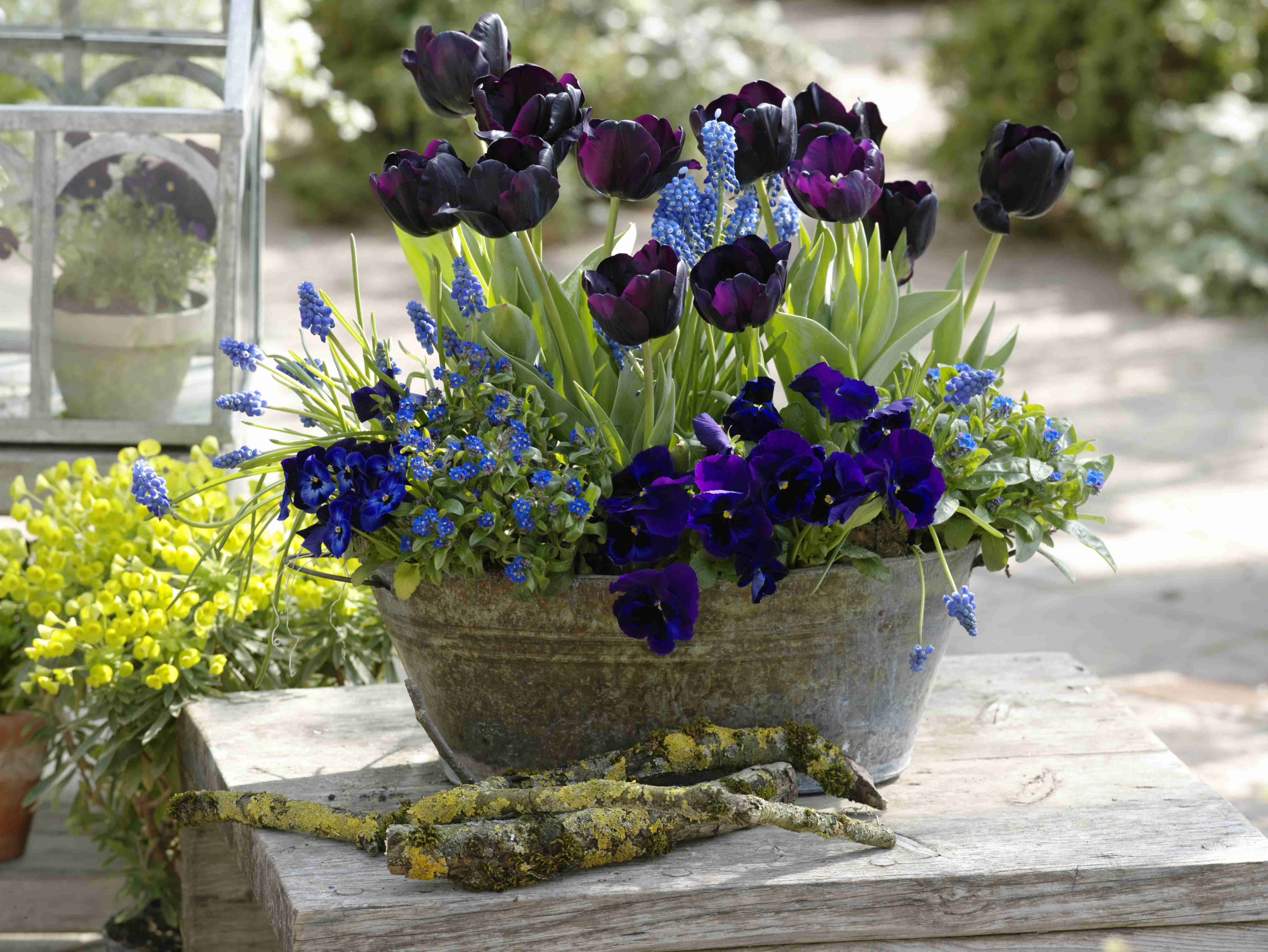
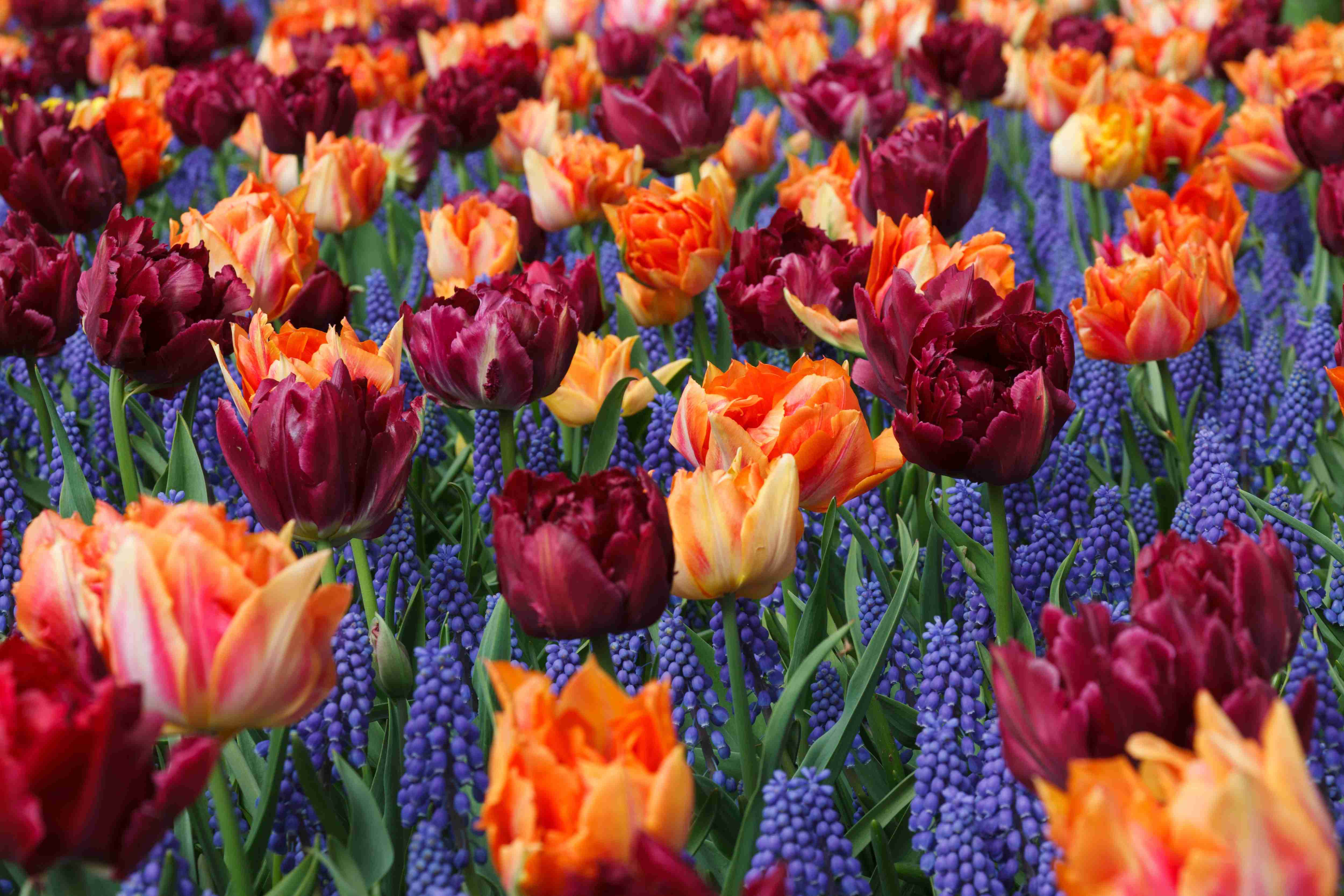
Comments